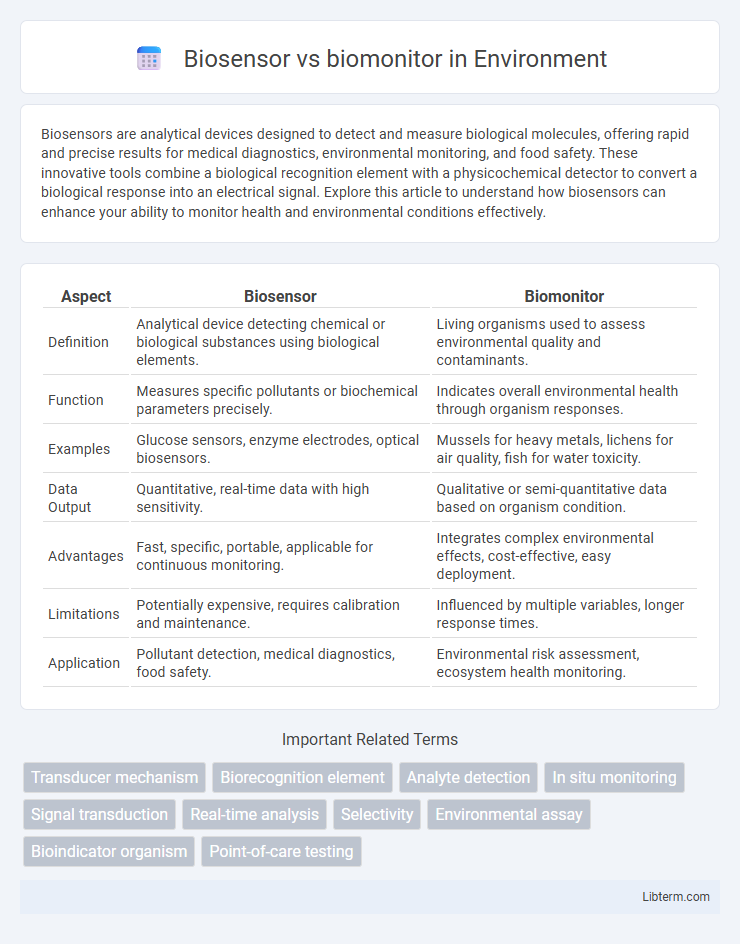Biosensors are analytical devices designed to detect and measure biological molecules, offering rapid and precise results for medical diagnostics, environmental monitoring, and food safety. These innovative tools combine a biological recognition element with a physicochemical detector to convert a biological response into an electrical signal. Explore this article to understand how biosensors can enhance your ability to monitor health and environmental conditions effectively.
Table of Comparison
| Aspect | Biosensor | Biomonitor |
|---|---|---|
| Definition | Analytical device detecting chemical or biological substances using biological elements. | Living organisms used to assess environmental quality and contaminants. |
| Function | Measures specific pollutants or biochemical parameters precisely. | Indicates overall environmental health through organism responses. |
| Examples | Glucose sensors, enzyme electrodes, optical biosensors. | Mussels for heavy metals, lichens for air quality, fish for water toxicity. |
| Data Output | Quantitative, real-time data with high sensitivity. | Qualitative or semi-quantitative data based on organism condition. |
| Advantages | Fast, specific, portable, applicable for continuous monitoring. | Integrates complex environmental effects, cost-effective, easy deployment. |
| Limitations | Potentially expensive, requires calibration and maintenance. | Influenced by multiple variables, longer response times. |
| Application | Pollutant detection, medical diagnostics, food safety. | Environmental risk assessment, ecosystem health monitoring. |
Introduction to Biosensors and Biomonitoring
Biosensors are analytical devices that combine a biological component with a physicochemical detector to measure specific substances, offering rapid, real-time monitoring of environmental, medical, and industrial parameters. Biomonitoring involves assessing the presence and concentration of chemicals or biological markers within living organisms to evaluate exposure and health effects over time. Both techniques play critical roles in environmental and public health by providing complementary data for accurate detection and assessment of biological and chemical hazards.
Definitions: What Are Biosensors and Biomonitor Devices?
Biosensors are analytical devices that combine a biological component, such as enzymes or antibodies, with a physicochemical detector to measure specific substances or environmental parameters. Biomonitor devices utilize living organisms or biological responses, like plants or aquatic animals, to assess ecosystem health and detect environmental changes. Both tools are essential in environmental monitoring, yet biosensors provide rapid, quantitative data, while biomonitors offer integrative, long-term biological insights.
Core Principles: How Biosensors Work
Biosensors operate by detecting specific biological molecules through a bioreceptor, which interacts with the target analyte and generates a measurable signal transduced into an electrical, optical, or thermal output. The core principle involves signal transduction mechanisms that convert biochemical reactions into quantifiable data, enabling real-time monitoring of analytes such as glucose or pathogens with high specificity and sensitivity. Unlike biomonitors, which assess whole-organism responses to environmental changes, biosensors provide precise molecular-level information through engineered analytical devices.
Biomonitoring Fundamentals: Techniques and Approaches
Biomonitoring Fundamentals encompass various techniques such as biological sampling, tissue analysis, and bioaccumulation studies, which provide direct insight into the exposure and effects of environmental pollutants on living organisms. Unlike biosensors, which rely on electronic or optical devices to detect specific biological responses in real-time, biomonitors utilize living organisms or their parts as indicators to assess long-term environmental health and contamination levels. This approach integrates physiological, biochemical, and ecological data to deliver comprehensive evaluations of pollutant impact on ecosystems.
Key Differences Between Biosensors and Biomonitoring
Biosensors are analytical devices combining a biological component with a physicochemical detector to measure specific substances, providing real-time data on target analytes such as glucose or toxins. Biomonitoring involves assessing human exposure to chemicals by measuring the levels of these substances or their metabolites in biological samples like blood or urine, reflecting cumulative exposure over time. Key differences include biosensors' immediate, targeted detection capability versus biomonitoring's comprehensive assessment of internal chemical burden for health risk evaluation.
Types of Biosensors and Their Applications
Electrochemical, optical, piezoelectric, and thermal biosensors represent key types, each leveraging different detection principles for precise measurement of biological analytes. Electrochemical biosensors, widely used in glucose monitoring, offer high sensitivity and rapid response, while optical biosensors enable real-time analysis in environmental monitoring and medical diagnostics. Piezoelectric biosensors apply mass-sensitive detection ideal for detecting pathogens, and thermal biosensors measure enthalpy changes, supporting applications in fermentation and enzyme activity studies.
Biomonitor Devices: Examples and Use Cases
Biomonitor devices include wearable heart rate monitors, glucose sensors, and environmental pollutant detectors, providing continuous real-time data for health and ecological assessments. These devices enable precise tracking of physiological signals and environmental changes, facilitating early disease detection and pollution management. Common use cases encompass chronic disease management, workplace safety monitoring, and wildlife habitat quality evaluation.
Advantages of Biosensors Over Traditional Biomonitoring
Biosensors offer real-time data acquisition and enhanced sensitivity compared to traditional biomonitoring methods, enabling rapid detection of specific biological or chemical substances. Their portability and automation facilitate on-site analysis, reducing the need for extensive sample preparation and laboratory processing. This technology also allows continuous monitoring, improving accuracy and efficient early warning for environmental or health-related changes.
Limitations and Challenges of Biosensors and Biomonitoring
Biosensors face limitations such as sensitivity to environmental conditions, limited shelf life, and challenges in miniaturization for in-field applications, which restrict their long-term reliability and accuracy. Biomonitoring struggles with variability in biological responses, ethical concerns regarding invasive sampling, and difficulties in standardizing data across diverse populations. Both methods require advancements in calibration techniques and data interpretation to overcome these challenges and improve environmental and health assessments.
Future Trends in Biosensor and Biomonitor Technologies
Future trends in biosensor technologies emphasize enhanced sensitivity through nanomaterials and integration with artificial intelligence for real-time data analysis. Biomonitor systems are advancing with IoT connectivity and wearable devices, enabling continuous environmental and physiological monitoring. Both fields show promising developments in personalized healthcare and environmental sustainability applications.
Biosensor Infographic

 libterm.com
libterm.com